=================================================================
To subscribe, unsubscribe or change your email address, visit:
http://www.imaging-resource.com/IRNEWS/index-subs.html
Support the Newsletter!
- Find the best price for anything at http://ir.pricegrabber.com
- Shop Amazon, Adorama at http://www.imaging-resource.com/buynow.htm
========================================================
THE IMAGING RESOURCE DIGITAL PHOTOGRAPHY NEWSLETTER
========================================================
Volume 16, Number 12 - 13 June 2014
----------------------------------------------------------------------------
Copyright 2014, The Imaging Resource. All rights reserved.
----------------------------------------------------------------------------
Welcome to the 389th edition of The Imaging Resource Newsletter!
Welcome to your regularly scheduled Imaging Resource Newsletter for June 13th! We've got another jam-packed issue for you all this week. To start things off, Mike Tomkins puts the finishing touches on this Fujifilm X-T1 review, with his third Shooter's Report installment. Switching gears and heading to the Rockies, reviewer John Shafer take the Samsung NX30 for a mountain bike ride, a selfie session and some high-quality Instagramming with this first Shooter's Report for this new flagship NX camera.
On the features side of things, more material from Dave Etchells' adventures in Japan for CP+, this time with Part I of II of a big discussion with Panasonic execs on the GM1, the new DFD technology in the GH4 snf lenses, including info on long telephoto for the Micro Four Thirds system. The interview's a doozy -- almost 9000 words long -- so, we've only put in a excerpt of Part I. (Stay tuned on the site for Part II, to go up either later this weekend, or early next week.)
In the Quick Hits section, it's good news for Sony fans. We continue with more testing for the new A77 II, this time with our full image quality and print quality analysis, as well as First Shots and sample gallery images for the hot new Sony RX100 III.
There's also a new camera model to welcome into the world: the Panasonic FZ1000. This large, 1-inch-sensor superzoom, sports up to a 400mm equivalent lens, 4K video recording, and a much lower price than its rival, the Sony RX10. And we've already got First Shots, hands-on info, and a quick image quality comparison again its main competitor, the RX10.
At long last, we also finally get to some reader questions, and then we share some of the most popular news stories from this past week, including our Sony 16-70mm f/4 Zeiss lens review, more information on the Sony A7S's low-light performance and new firmware features, and a couple of articles from Roger Cicala of LensRentals, investigating a handful of 50mm lenses and an interesting find regarding lens adapters and sensor design.
Happy reading!
---
EDITOR'S NOTE: New newsletter email address - nleditor@imaging-resource.com
We apologize to all of our reader's who've emailed us for our long-running reader emails and questions section of the newsletter and never received a response. Our old newsletter editor email address got completely overwhelmed with irrelevant PR emails and spam, to the point that it just wasn't workable to sort through the hundreds and hundreds of messages to find the reader queries. The new address -- nleditor@imaging-resource.com -- is pristine, though, so we'll be able to easily see and respond to all of you, just like old times. Have a question or comment? Just ask!
Oops!
Additional apologies to everyone who received two copies of the last issue of this newsletter. Because of how our mailing list is split up, not everyone got the extra copy, but it was probably a good 90% of you. What happened was that I accidentally hit "send list message" at one point, I meant to click "send test message". I do the latter to check formatting in my email client, but this time accidentally sent a copy to the main list, and didn't realize I had until I'd dispatched the main mailing (the on-purpose version). Once both copies were sending, I couldn't reliably stop one without stopping both, and I figured that a complete restart delivering a *third* copy for some people would be really over the top. Ditto sending a message to let everyone know what had happened. So personal apologies to those of you who received a redundant copy. We obviously think our newsletter is worth reading, but perhaps not reading twice!
---
TOPICS
------------
- Get Social with IR
- Sponsors
- Reviews:
- Fujifilm X-T1 Shooter's Report Part III
- Samsung NX30 Shooter's Report Part I
- Feature:
- Panasonic Q&A Part I: Why no long-telephoto lenses, and Depth From Defocus details
- Quick Hits:
- Sony A77 II Image Quality Analysis
- Sony RX100 III First Shots, Sample Gallery
- New Product Announcements
- Panasonic FZ1000 (+ First Shots and IQ Analysis)
- Reader Mail
- Popular News
- Next Issue
- Signoff
GET SOCIAL WITH IR
----------------------------------
If you want to stay up-to-date with the latest camera and photography news, get notified when IR posts its latest camera or lens review, and much more, get social with us on your favorite networking sites by:
By doing so, you'll also be supporting our efforts to deliver the best camera and photography content on the planet. (Google in particular appears to pay lots of attention to Google+ in deciding site/page relevance for its search results, so "circling" us there and +1-ing our site and pages would be an especially big help.) Thanks! We appreciate it!
SPONSORS
-----------------
This issue is sponsored in part by the following companies. Please show your appreciation by visiting the links below. (Visiting our sponsor's links really helps support this newsletter, thank you for your attention!) And now a word from our sponsors:


* Sigma *
---------
Sigma's approach to photographic equipment is based on quality, craftsmanship, value, customization and
responsibility to photographers and the environment. All encompassed in our breakthrough, award winning
Global Vision lenses:
18-35mm F1.8 DC HSM
35mm F1.4 DG HSM
17-70mm F2.8-4 DC Macro OS HSM
120-300mm F2.8 DG OS HSM
USB Dock
All designed to deliver the highest optical quality and performance.
-----------------------------------------------------------------------------------------------------
Are you in the digital photo business? This newsletter is read by more than 47,000 direct subscribers (plus additional pass-along readers), all with a passion for digital photography. For information on how you can reach them, contact us at nleditor@imaging-resource.com
-----------------------------------------------------------------------------------------------------
Camera Review: Fujifilm X-T1 Shooter's Report Part III
Of hot rods and blimps...
by�Mike Tomkins
During my two weeks in Hong Kong, I had plenty of opportunity to test out the Fuji X-T1 in all manner of shooting situations -- or at least, most of them. There wasn't much opportunity for shooting sports or active subjects, so I saved that for my return to Knoxville, TN.
And then my PC died, leaving me scrambling to repair it, and causing me to miss a planned sports shoot -- but fortunately there was a car show in town once I was done with the hassle of resurrecting Windows.
|
To test the X-T1's autofocus chops,�I took it to a car show. The gorgeous retro body looked right at home in the company of vintage cars like this 1969 Chevrolet Camaro RS/SS 396! |
The Hot Rod Power Tour in Knoxville's Chilhowee Park promised lots of color and visual interest, but at first blush, not a lot of action. As it happened, though, I found a good spot from which to shoot near the exit to the car park as all the hot rods, classics, and not-quite-so-classics (including everything right down to the infamous Chevy Nova) were leaving for the day.
I settled in at end of a short straight section on the outside corner of a turn, so that the cars were coming straight towards me, and shot with the 55-200mm lens to frame tightly.
From the time the cars took to traverse the length of the road, I'd estimate that they were moving at 25-30mph, which while not spectacularly fast, still meant a fair amount of focus adjustment to track with each vehicle. And as an added bonus, the speed wasn't constant either -- there was first acceleration towards me while I was trying to achieve a focus lock, followed by deceleration for the corner. (And I panned to follow each car through the start of the turn.)
|
Straight away,�I hit two problems. One I should have expected -- that frustratingly easy-to-bump exposure compensation dial. The other I wasn't expecting -- a significant viewfinder lag that made framing difficult. This could've been a great shot, but I cut the car off just slightly due to the lag. |
Straight away, I hit my old "friend", the Fuji X-T1's easily-bumped exposure compensation dial. Reviewing my first few shots, I accidentally dialed in +2/3EV exp. comp. -- not enough to immediately notice through the viewfinder, but enough to clip the highlights under dappled sunlight through trees, since I was shooting JPEG-only at the time.
Fortunately, I caught the problem after a few cars, but it was a bit of a shame to lose these images, especially since one of the prettiest cars at the show was amongst them.
Another unwelcome surprise in those first few shots was the X-T1's viewfinder lag. I've praised it in my earlier shooter's reports, and for ordinary shooting it's exceptionally fast-reacting, by electronic viewfinder standards. When shooting bursts in Continuous High drive mode, though, it's much more bothersome.
I think what's actually happening is that the X-T1 isn't showing the live image between frames at all, just a review of the last image shot. It's something we've seen and commented on with other cameras before, but I must admit given the X-T1's otherwise-swift viewfinder, I wasn't expecting to see it here.
|
Although the viewfinder lag�during burst shooting means it wouldn't be the ideal sports camera, the Fuji X-T1 did a reasonably good job of keeping up with these cars head-on at around 30mph. |
To try and quantify the scale of the problem, I used another camera to film a video showing both the X-T1's live view feed and a flashlight positioned so that it was visible to both cameras. Then I stepped through the video (shot at 60 frames per second) and compared when the camera filming the video first showed light from the flashlight, and when it appeared in the X-T1's live view.
When simply framing with the X-T1 but not shooting, there was precisely one frame of 60p video between the flashlight switching on or off, and the live view feed showing it happen. During Continuous High shooting, though, the delay soared to a full 10 frames of 60p video, or around 1/6th of a second.
That lag made it quite tricky to frame accurately with the X-T1 in burst shooting. What my eye was seeing lagged what my hands were doing -- and with a fairly powerful telephoto, even the slightest twitch of my hands made a significant change to the scene. The result, initially, was that I'd overshoot my intended framing adjustment, then once I realized I'd done so a sixth of a second later, I'd overshoot a correction in the opposite direction. I felt more like I was chasing my subjects than framing them.
It reminded me of another situation with a Fujifilm connection, from a decade and change ago. At a trade show in Las Vegas, NV, Fuji were kind enough to invite me on their blimp, and (this being a pre-9/11 world) the pilot invited me to take the controls for a little while -- with close supervision, of course. Shooting with the Fuji X-T1 reminded me of flying that blimp, and of the pilot's advice on correcting my initially-rather-erratic course.
|
After a little while,�I got used to the lag and learned to think ahead of the camera. With that experience under my belt, I could frame tightly as I wanted, but it did take some practice. |
Blimps take a while to respond to control movements, and so in my brief flight time, I had to learn to overcome the urge to respond to what I was feeling happen, and think ahead of the craft. I had to do much the same with the X-T1 -- think ahead, and fight the urge to respond to what I was seeing in the VF.
While I'd have been happier zooming and panning to follow these moving cars with a DSLR that showed the real scene between frames, it�was�possible to learn to work with the lag, and to get at least reasonably close to the framing I was going for. That is, until the cars were well into the corner, just 30 feet or so in front of me, and I had to pan sideways very quickly. At that point all bets were off, but by then it was also too tough a challenge for the autofocus system most of the time anyway.
Which brings me nicely back to autofocus -- the very thing I'd originally been intending to test. And how did the X-T1 perform? I'd say the results were fair, but not stunning. Perhaps 20-30% of my shots didn't quite nail focus, but the overwhelming majority were at least close. (And I was pixel peeping here -- printed or viewed full-screen, I'd say nine out of ten images were sharp enough.)
Also, when focus tracking did drift a little astray, it usually returned to a good focus within just a frame or two. Only once in hundreds of frames did it run wild, going extremely far out of focus. That was when I was panning to follow the car I was shooting, which was almost at its closest point, and moving quite quickly relative to the camera. Excluding that one instance, though, focus stayed at least close to the ballpark.
|
The classics kept rolling�and I kept shooting, scoring some really nice results straight out of camera. Fuji's JPEG rendering was just to my taste, more so than Adobe Lightroom and Camera Raw's defaults. |
Another thing I particularly wanted to get a handle on before rendering my verdict on the X-T1 was raw file processing. This is the first X-Trans sensor-based camera which I've fully reviewed, but I'm aware that for quite some time, third-party support for Fuji's unusual X-Trans color filter array was rather less than optimal.
My understanding is that the reasons for this were twofold: one being that supporting X-Trans in the first place required a pretty significant development effort that would only pay off for a relatively small number of photographers, compared to the market for Bayer-filtered cameras. That, coupled with the complexity of demosaicing the X-Trans array -- and the fact that many image processing algorithms used by third-party apps had been developed with Bayer cameras in mind -- meant a lengthy delay for support in the first place, and some image quality issues even once support arrived.
It was my understanding that this had been largely resolved as X-Trans has matured, but really, I wanted to see for myself. As I'm predominantly a Lightroom user, I started there, but I also looked at Photoshop, DxO Optics Pro, and researched the situation with some other key apps.
Using Adobe Photoshop Lightroom 5.4, images from the Fuji X-T1 imported without any fuss at all, and I didn't notice anything untoward in Adobe's rendering of the images. Obviously, Lightroom does render a little differently from the out-of-camera JPEGs. I found that the in-camera profiles -- Provia, Velvia, Astia, Pro. Neg. and Monochrome -- which were recently added by Adobe make things quite a bit closer to their out-of-camera equivalents, though. (And these really are nice to have, if you're a fan of the camera rendering.)
|
There's something�about classic American muscle cars that really gets my pulse racing in a way that modern cars just don't. This 1965 Pontiac GTO is a very nice example of the breed. |
Sadly, these aren't available in Photoshop unless you're a Creative Cloud subscriber. I've so-far resisted upgrading because I haven't seen any feature compelling enough to persuade me to pay an ongoing subscription, so I'm still on Adobe Photoshop CS5. That means I can't open the X-T1's .RAF raw files out of the box -- first they have to be converted with Adobe DNG Converter.
I used version 8.4 to do so, then had a play with the settings, but immediately noticed the absence of any camera profiles except Adobe Standard. Photoshop Camera Raw's rendering of the images was otherwise much like that of Lightroom, which isn't really surprising given that they're based on the same underlying engine.
I had a feeling that DxO Optics Pro wasn't going to touch the X-T1's raw files, as I knew last I'd checked that the French software company hadn't adopted support for X-Trans. Sure enough, that's still the case, and there's no sign of it changing any time soon.
My understanding is that the reason for this is DxO's unique algorithms, which so beautifully correct for a wide variety of defects, but are closely tied to the presence of a Bayer CFA. Reworking these for the X-Trans CFA would need a major rewrite, and DxO hasn't yet seen sufficient demand to justify all that work. Nor can Optics Pro handle converted DNGs from the X-T1.
|
And then...�this appeared. I have no idea what this hot rod's lineage is, but it's certainly eye-catching! |
The great shame here, though, is that means X-T1 owners won't have access to DxO's excellent PRIME denoising engine, which in my opinion is the best in town at the moment, albeit a bit slow because it works by throwing vast amounts of processor power at the problem.
I was pleased to find, though, that the other main players -- Apple's Aperture and iPhoto, and Phase One's Capture One -- all support the X-T1 in their current releases. I'm personally not a fan of Capture One's interface, and I don't own any Mac hardware, so I didn't give these a spin. It's my understanding that, like Adobe, these competitors also do a fairly good job at this point.
So, it seems that with the sole, sad exception of DxO Optics Pro, third-party support is now up to snuff. That's good news, and it leaves me with only one other feature I wanted to return for another look at: Wi-Fi support. I'd mentioned in a previous Shooter's Report that I used Wi-Fi quite a bit on my trip, but this was with the more basic of Fuji's two available apps, "Fujifilm Photo Receiver".
The Photo Receiver app simply allows transfer of images from camera to phone, with your selections made on the camera. A second app, "Fujifilm Camera Remote", is more comprehensive, providing not only for image download, but also for remote browsing of the camera, geotagging of images, and remote control.
|
By day's end�I got fairly good at framing despite the lag, zooming out and panning to follow cars into the corner with the tight framing I wanted. Here, I believe, an early 70s Pontiac Firebird Formula. |
Although I wasn't a big fan of the app's interface, I did quite like the remote control capability. Range was fairly good -- perhaps 50-60 feet with a wooden floor in between camera and phone seemed about the limit before the live view feed became unusable. (But it reestablished seamlessly, as soon as I moved back a bit closer to the camera.) And lag was relatively short, as well -- perhaps a little more than a tenth of a second. The ability to tap on the live view feed to select a focus point is also nice.
The layout is a bit bizarre, though. There's only a very small window in which to see the live view feed in portrait orientation, and the app won't rotate to landscape orientation. Most of the screen around the live view feed is packed with controls and status displays. I'd have expected tapping on the status displays to provide the option to change exposure variables, but it doesn't.
Instead, a single exposure variable is highlighted beneath the status display -- either aperture or exposure compensation. Left and right arrows select a value, and clicking on the button between lets you select the other variable. Beneath is a Shutter button control, with two buttons on either side. The left button pulls up a shooting menu, and the right button an ISO menu. Yet the very top item for adjustment in the shooting menu is ISO sensitivity, even though it has its own dedicated button.
The shooting menu provides access to options such as film simulation, white balance, macro, flash mode, and self-timer -- but not shutter speed. And it seems there's no way to access this function at all, nor to choose to shoot in Program mode, so you're limited only to Aperture-priority shooting. (And this is with the camera body itself set with all dials in their Auto positions.)
|
No awards�for guessing what car this is! A beautiful mid-60s Ford Mustang in the late afternoon sun... |
There's also a slider which, when touch-dragged, switches between still and movie capture, and a playback button to take you to the image browser. This last is a nice touch, because it allows immediate transfer without having to disconnect from the camera and re-pair. You can select multiple images at a time for transfer, but sadly there's no way to see anything larger than a tiny thumbnail. (And my HTC One X+ phone has a relatively large screen; many phones would should the thumbnails at an even smaller size.)
The Receive option on the main screen of the app provides much the same interface as the standalone Photo Receiver app, so there's really no need to have both apps installed. Browse Camera, meanwhile, provides basically the same interface used for selecting images from the Remote Control mode, again with only tiny thumbnails.
And finally, the Geotagging function piggybacks on your phone's GPS receiver and uses this to determine the capture location of each image. After tapping the geotagging button in the app's main menu, the phone's GPS receiver is enabled and location logged for up to 60 minutes. This I couldn't get to work, even though geotagging was enabled in the camera's menu.
Even if I could, though, I wouldn't really find it useful. My phone already has short-enough battery life without running its GPS receiver for an hour at a time just in case I happen to take a photo -- and I really don't feel like waiting for Wi-Fi to connect so I can start and stop the GPS service ad-infinitum. Geotagging is a feature that belongs in an in-camera GPS receiver or a dedicated GPS accessory, not in my phone.
But be that as it may, the more expansive Wi-Fi app did prove worthwhile, if only for the remote control capability and its mirror of the Photo Receiver app features. I think I'd probably stick with this version simply because, knowing my luck, the one time I uninstalled it I'd find myself out of cellular connectivity and wishing I had the remote control mode available.
And that about does it for my final Fuji X-T1 Shooter's Report. Looking back over my time with the camera, I found plenty to love, and a few things not to like quite so much. Probably key among these are the too-easily-bumped exposure compensation dial, and the hard-to-press rear-panel buttons.
I really did like the size benefit over my DSLR, though, and image quality was pretty good too. And with the aforementioned control quirks aside, there's just something about the X-T1's aesthetic and build that screams "enthusiast camera". The absence of a mode dial -- and presence of auto positions on the other dials -- is incredibly intuitive, and I'm going to miss it when I return to my daily shooter. Warts and all, I found myself reaching for the X-T1 over my other cameras a lot of the time when I went out shooting, and wanted interchangeable lenses.
Earlier in this review, I compared it to another retro-styled camera, the Nikon Df. I think what Fuji has crafted here is an altogether better thought-out shooter than that camera, one in which the retro aesthetic works, rather than gets in the way. Were I in the market for a new interchangeable-lens body -- and willing to switch mounts -- today, the Fuji X-T1 would definitely be on my shortlist.
Read more about the powerful Fujifilm X-T1 over on the site for all the details.
---
Camera Review: Samsung NX30 Shooter's Report Part I
A comfortable, lightweight camera with great specs and performance
by John Shafer
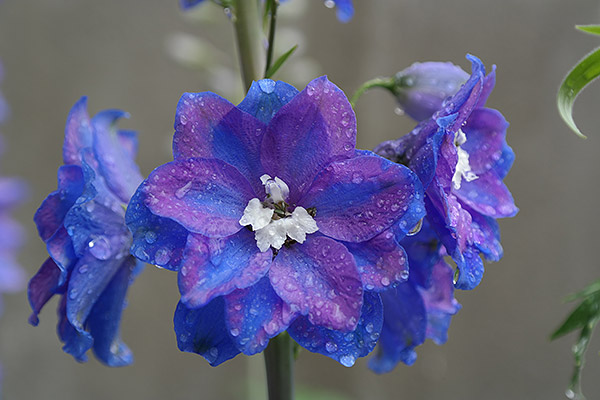 |
NX30 + 18-55mm Kit Lens: 48mm, f/6.3, 1/100s, ISO 200, -0.3EV |
This was my first opportunity to spend some quality time with a Samsung interchangeable lens camera, and I was really looking forward to it. On paper, Samsung NX cameras have a very competitive feature-set and excellent performance specs. I was excited to see how the NX30 performs compared to other mirrorless cameras I've used -- especially at action performance and image quality. Samsung sent me the NX30 in a kit with an 18-55mm f/3.5-5.6 image-stabilized zoom lens. The camera is spec'd with a 20-megapixel APS-C CMOS sensor, built-in Wi-Fi with NFC, 9 frames per second high-speed burst, hybrid auto focus, a built-in electronic viewfinder (EVF), 3-inch AMOLED touchscreen display, i-Function control system, and Full HD video at 60 frames per second. It definitely looks great on paper. But do those specs measure up to a great camera in real life?
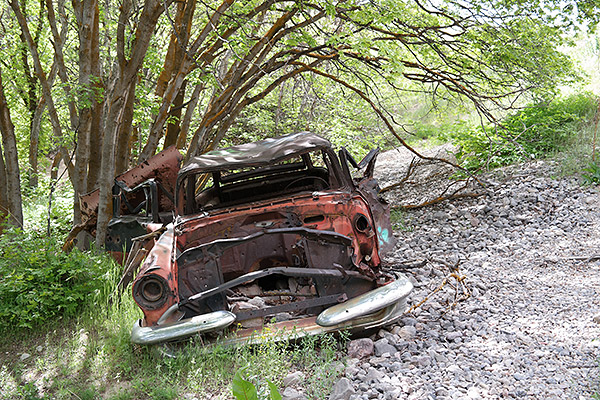 |
NX30 + 18-55mm Kit Lens: 29mm, f/5.6, 1/100s, ISO 200, +0.3EV. |
In this first part of my NX30 shooter's report, I'll share my general, first-impressions of the camera -- handling, basic elements, image quality, and standout features -- especially the built-in Wi-Fi, electronic viewfinder and the i-Function controls.
Getting acquainted.�I spent my first few days with the NX30, shooting with the standard 18-55mm f/3.5-5.6 ED OIS kit lens. It's a solid, basic zoom and it has surprisingly good image quality for an inexpensive kit lens. However, with that slow variable aperture and short (but typical) zoom range, it is a somewhat limited lens. I think it's fine for general snapshot and travel photography. But for anything more technical or serious, I'd prefer to have either a longer zoom (I really like 18-200mm zooms for APS-C sensor cameras) or more lenses. That said, I did take plenty of photos with the 18-55mm lens that I'm happy with -- family stuff, street photos, landscape, food porn for Instagram, and even some action photography. Like I said, it's very good for a kit lens. It may not have a lot of range or a fast aperture, but it's sharp from edge to edge, it's got nice snappy contrast, and the bokeh is surprisingly good for a variable aperture lens. Of course, I w
ould have preferred to shoot with Samsung's new 16-50mm f/2-2.8 S ED OIS zoom -- one of the fastest zoom lenses available. However, it's US$1,200 and the 18-55mm is what most buyers will start with, so that makes it a good lens for me to start with, too.
 |
Salt Lake City Graffiti Art: I included this image to show how good the edge-to-edge sharpness is with Samsung's 18-55mm f/3.5-5.6 OIS kit lens. It's really impressive for a lens in this category.�
(NX30 + 18-55mm Kit Lens: 40mm, f/5.6, 1/200s, ISO 100, +0.3EV.) |
In the hand.�The first thing I noticed when I opened the box was the NX30 is much smaller and lighter than I expected. Because of the bulging EVF on top of the camera and the large (larger than some mirrorless cameras, anyway) APS-C sensor, I expected it to be bigger. However, sometimes first impressions can be misleading. Just to make sure my touchy-feely impressions were accurate, I consulted the Internet to find out how it compares to some other cameras. It turns out the NX30 isn't as small as I thought -- possibly because I've been shooting with a couple of larger DSLRs lately. It's definitely smaller than most DSLRs, including Canon's advanced entry-level camera, the EOS Rebel T5i / 700D. However, it's actually a bit larger than the Canon EOS Rebel SL1 / 100D, currently the smallest DSLR on the market. And compared to the comparably-spec'd Sony A6000 mirrorless camera, it's positively huge. That said, it still felt pretty small and light to me. Part o
f that is the 18-55mm kit lens, which is quite light and constructed mostly of plastic (thankfully, it does have a metal lens mount). The NX30 body is also very light and feels a bit plasticky, too. I don't have a problem with the feel but I know there are plenty of photographers who require their cameras to feel burly and metallic. For me, as long as it gets the job done and doesn't break, I've got no complaints.
In the end, even though the NX30 is bigger than I initially thought, I found it to be quite portable, which means you're less likely to get lazy and leave it at home. It was especially nice for me to carry in my pack while mountain biking, where every ounce counts. It was a lot easier on my back and legs than the big DSLRs I usually ride with.
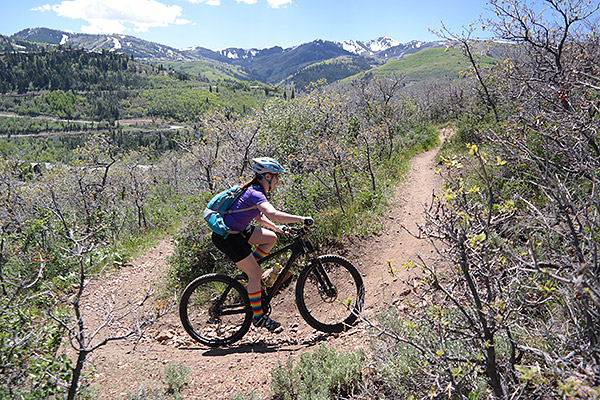 |
Spring Mountain Biking In Park City: This photo includes my lovely wife and favorite mountain biking partner and model, Jenni.
(NX30 + 18-55mm Kit Lens: 18mm, f/3.5, 1/1250s, ISO 200, +0.3EV) |
Controls.�With the exception of Samsung's i-Function feature, which I'll get to later, the NX30's controls are pretty much standard for an intermediate DSLR. It has a mode dial with PASM, Auto, "Smart" scene modes, "Lens Priority," two user-programmable custom modes, and a Wi-Fi setting for accessing the camera's Wi-Fi options. For exposure control there's one control dial behind the shutter release, and on the rear there's an exposure compensation button along with a 4-way controller and dial that functions as a second exposure control when you're in full manual exposure mode.
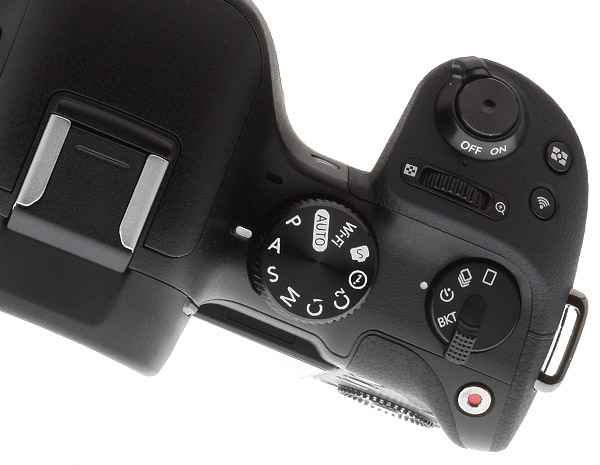 |
Samsung NX30 Top Deck Controls: The NX30 has a mode dial with PASM shooting modes, Auto, user-customizable modes, and a Wi-Fi position for accessing the camera's Wi-Fi features. Note that it also has a dedicated "Drive dial" for accessing the self-timer, bracketing and high-speed burst shooting modes. |
Display.�The NX30 also has a beautiful 3-inch AMOLED touchscreen display that offers access to a bunch of functions just by touching the screen. The most useful of those features is focus -- just touch where you want to focus on the display, and that's where the camera focuses. Combine that with the fully articulated display, and the NX30 is a great self-portrait camera -- just flip the monitor around so it's facing the front of the camera, touch the screen where you want it to focus (usually on an eye), and then press the shutter release.
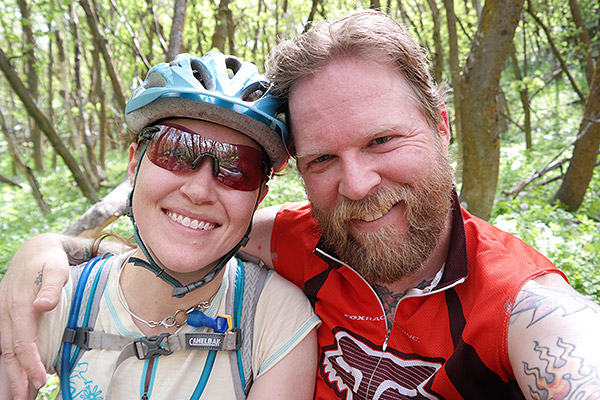 |
Happy Mountain Bike Couple Selfie: This self-portrait taken on one of our first mountain bike rides together in nearly a year, due to an injury I had last June, sums up the feeling of the day quite well. It was easy to take, thanks to the NX30's fully articulating display with touchscreen controls, including touch focus, which allowed me to easily focus the camera on my face.�
(NX30 + 18-55mm Kit Lens: 18mm, f/5, 1/60s, ISO 200, +0.3EV.) |
EVF.�Some photographers will no doubt view this as blasphemy, but over the past few years I've come to prefer electronic viewfinders to optical viewfinders. Five years ago, the quality of most EVFs was pretty poor. They were grainy, lacked saturation and contrast, and they refreshed too slowly and blacked-out when you used the burst mode. That's not the case anymore, though. In 2014, a good EVF is bright, sharp and quick, and arguably a better tool than a traditional optical viewfinder, allowing you to view the histogram and all the other data and info you'd usually have to check the monitor to see. The EVF is especially good for shooting video because it helps smooth out handheld video -- and unlike the optical viewfinder on a traditional DSLR, it actually works when you're recording video. �The Samsung NX30 has a very interesting, one-of-a-kind EVF that can be pulled out and tilted up to 80 degrees for shooting awkward angles. I used it to shoot some ver
y low ground cover flowers in my backyard and it worked very well, allowing me to keep the camera up to my eye so it was more steady and I could frame the photo more comfortably than if I tried to lay on my stomach or use just the monitor.
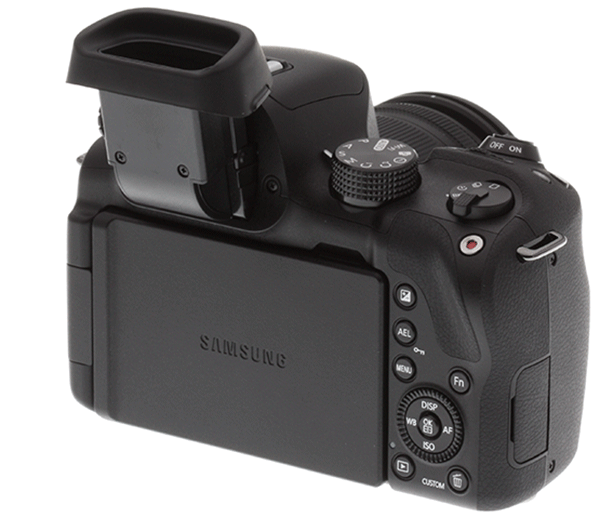 |
Samsung NX30 Tiltable Electronic Viewfinder: The NX30's 2.4M-dot EVF is quite nice and the unique tilting ability is really nice when you want to shoot at low angles and keep your eye to the viewfinder. |
i-Function Control.�One of the most interesting features on the Samsung NX30 is the i-Function control system. I neglected it at first because it's not at all a standard camera control. However, I'm now making a conscious effort to use it because I think it's great. Basically, there's an iFn button on the lens barrel that gives you quick, single-button access to important camera settings like aperture, shutter speed, exposure compensation, ISO and white balance. And if the mode dial is set to�i�(Lens Priority), the i-Function button offers i-Contrast and i-Depth controls -- self-explanatory, user friendly contrast and depth-of-field controls for less experienced photographers who want more creative control.
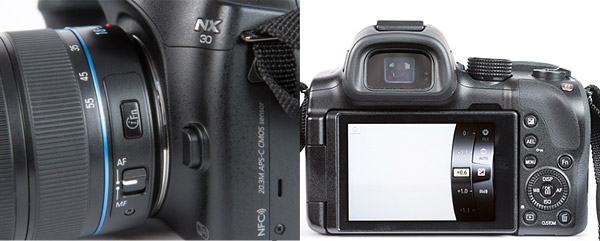 |
Samsung NX30 i-Function Controls: The iFn button on the lens barrel of selected Samsung lenses (left) gives quick access to regularly used settings like aperture, shutter speed, exposure compensation, ISO, etc. The UI for the i-Function controls is very intuitive (right) and it's nice that you can also use it while you're using the EVF.
|
I especially like the i-Function controls because I think the NX30's standard exposure controls fall a bit short of perfect. And as I get more comfortable with using the iFn button and it becomes more intuitive, I am less concerned with the awkwardly-placed exposure compensation button and the dual-purpose exposure control dial / 4-way controller on the back of the camera.
Wi-Fi.�Last but by no means least -- the NX30 has a very sophisticated built-in Wi-Fi system that you can use to transfer photos and videos to a smartphone, backup photos to the cloud or your computer, or use your smartphone as a wireless remote control -- you can even use the camera as a wireless baby monitor. I started using in-camera Wi-Fi a few years ago with an Eye-Fi card, and now I don't want to live without it. I mostly use it to share photos to Instagram and Facebook via my phone, although I also appreciate being able to use my phone as a wireless remote control.
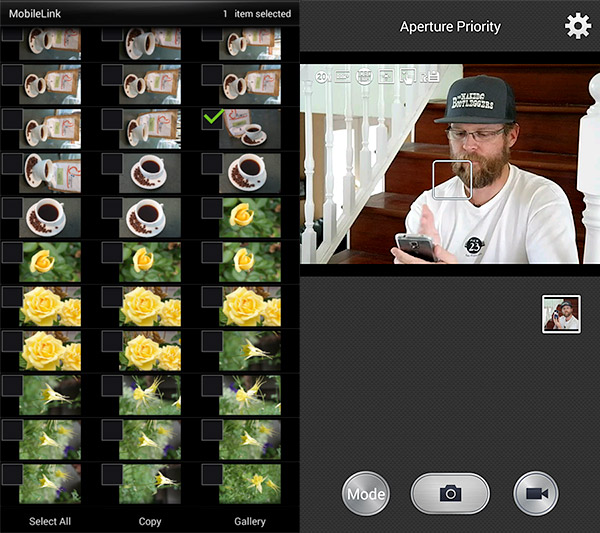 |
Samsung Mobile App Screenshots: Screenshots of Samsung's Smart Camera app, installed on my Samsung Galaxy S5 phone. The app interfaces with the NX30's Wi-Fi features. On the left is the MobileLink screen, which displays photos stored on the camera. So what you're seeing are actually images on the camera. The checked image is one I'm about to wirelessly transfer to my phone so I can share it on Instagram. On the right is the Remote Viewfinder screen -- that's a live view image of me, wirelessly streamed from the camera to my phone. You can see in the image that I'm in the process of making the screenshot you see above. Don't think too hard about it -- it will make you dizzy. Sample photos using both Wi-Fi features are below. |
To use the NX30's built-in Wi-Fi you have to install the Samsung Smart Camera App on your phone and connect your phone to the camera's Wi-Fi network. I found the connection process with the NX30 to be a bit fiddly, but I did get it to connect. To be honest, I've had some difficulty with the built-in Wi-Fi on most cameras. While the NX30 wasn't the easiest I've used, it wasn't the worst, either. Once you've got your phone to recognize the camera, it's a lot easier to connect. And if you have a phone with NFC (Near Field Communication), all you have to do to reconnect is tap the back of the phone on the NFC badge on the left side of the camera and they will automatically connect. Then it's just a matter of selecting the photos you want to save to your phone. Once you've saved them, you can treat them exactly as you'd treat a photo you took with your phone.
My standard practice is to process them with Snapseed and then upload to my Instagram account. Even the best smartphone can't compare to a good point-and-shoot, let alone a camera like the NX30. I love being able to use a camera with great image quality and depth-of-field control for my 'food porn' photos. The NX30's built-in Wi-Fi means I don't have to wait for a computer to share them to Instagram.
 |
Samsung NX30 Instagram Image: Transferred to my phone with Samsung's Smart Camera app. Then I processed it with Snapseed and uploaded it to my Instagram account. Click to view the original photo.
(NX30 + 18-55mm Kit Lens: 45mm, f/5.6, 1/40s, ISO 3200) |
Samsung's Remote Viewfinder wireless remote option is very impressive. It allows you to use your phone as a remote control, via the Samsung Smart Camera App -- complete with live view display. It isn't just a simple remote, either. You can choose the shooting mode, manually adjust aperture, shutter speed, ISO and white balance -- even use the touch focus feature to control where the camera focuses. Here's a picture I took of myself with the NX30, using the app on my Samsung Galaxy S5 phone. The Remote Viewfinder feature takes selfies to a whole new level.
 |
Samsung NX30 Remote Viewfinder Photo: At first glance this just looks like a photo of some silly bearded dude showing off his smartphone. However, it's actually me (a silly bearded dude), taking a picture of myself with the NX30's Remote Viewfinder wireless remote control feature. What you see on my phone is the Remote Viewfinder live view display of what the camera is seeing, and I'm in the process of pressing the shutter release button and taking a picture. Full manual exposure controls are available if you press the little gear icon at the upper right-hand corner of the screen, too. This was taken in aperture priority mode and I was able to selectively focus on my face by using the touch focus on the live view display on my phone. It's a very powerful and effective remote control system.
(NX30 + 18-55mm Kit Lens: 55mm, f/5.6, 1/60s, ISO 3200, +1EV.) |
Initial Thoughts.�The Samsung NX30 is a very nice camera, with a lot of performance and cool features packed into a reasonably compact package. I shot a pretty good variety of subjects in a wide range of conditions with it in the first week, and for the most part, I was pleased with the results. I especially liked having the built-in Wi-Fi to feed my Instagram habit.
Up Next.�The guys at Imaging Resource HQ sent me a couple of new lenses to use with it so I've been able to expand my shooting options and in the next installment of my shooter's report, I'll get into a more technical evaluation of the NX30's performance features, including speed, auto focus, exposure and image quality.
Read more about the Samsung NX30 over at Imaging Resource, including the full set of lab images and more sample gallery images.
-----------------------------------------------------------------------------------------------------
FEATURE: Panasonic Q&A Part I: Why no long-telephoto lenses, and Depth From Defocus details (EXCERPT)
by Dave Etchells
I met with a number of camera company executives at the CP+ show in Yokohama, Japan this past February, and have already posted transcripts of a number of those interviews. (In the rough order in which I've posted them:�Nikon,�Canon,�Ricoh / Pentax, Fujifilm,�Sigma,�Foveon, and an earlier�Panasonic Q&A about onion-ring bokeh.) The press of everyday work once back home has meant that I still haven't managed to finish posting some of the longer exchanges, though.
I'll be trying to get some more of my material from that trip onto the site over the next few weeks, but here's a first down payment on what's still owing: The first part of a two-part, extensive discussion I had with two Panasonic representatives, Mr. Yoshiyuki Inoue and Mr. Michiharu Uematsu. Inoue-san is a very senior product planner for Panasonic, and Uematsu-san plays a very active role in communicating about Panasonic's new products with the press and Panasonic operating companies worldwide, as well as carrying product feedback to the planners and engineers in Japan.
I've known both gentlemen for a number of years now; regular readers will recognize both their names from previous interviews. The three of us found a little caf� far from the show floor, and spent some time discussing Panasonic's products and technology. "Some time" is a bit of an understatement, though; it ended up being an hour-and-a-half conversation covering a wide range of topics, including a number of reader questions and suggestions for firmware changes.
At almost 9,000 words, the full interview is way too long for a single news item, which is why I've split it into two parts -- this one, and a second part which will follow in a few days. We started off talking about one of my favorite cameras, the Panasonic GM1. In the transcript below, I'm "DE", and the other two gentlemen are identified by their last names.
 |
The Panasonic GM1 is one of my personal favorites. This shot next to Panasonic's own GX7 (a fairly typical-sized Micro Four Thirds model) shows just how incredibly tiny the GM1 is. Amazingly, these two cameras share the same sensor, and can use all the same lenses. |
How is the Panasonic GM1 doing in the market?
Dave Etchells/Imaging Resource:�We gave the Panasonic GM1 an award in 2013, as the best compact interchangeable-lens camera. There really wasn't anything else in that category then, and it's been extremely popular with our readers. How has it been received by the market in general? Is it meeting your expectations?
Yoshiyuki Inoue/Panasonic:�The GM1? In the US or worldwide?
DE:�I guess both in the US and worldwide.
Inoue:�As you can probably understand, it's very popular in East Asia. It's an interesting topic: In France, it's very popular, I think because it's very fashionable. But that's only France. Germany is not so popular.
Michiharu Uematsu/Panasonic:�Actually, almost all the European countries. In Italy it's very well accepted. In France, though, even before the GM1, the GF-series was very well accepted. This is a very special phenomena in France. For example, in Germany, they prefer the G or GH. And also in the UK, just the G.
DE:�Very interesting, so in most of the Euro zone, they prefer the bigger cameras?
Uematsu:�Yes, the French prefer a unique product, and also smaller.
DE:�How about the US, how is it being accepted there?
Inoue:�So-so.�[laughs]�But it's accepted as a second camera for professionals.
DE:�That's interesting because, even though I'm an enthusiast photographer, if I was buying a new camera right now, that's probably the one that I'd buy. Because it's so compact, and also because the Micro Four Thirds system has a lot of good lenses available for it. I find it appealing because it actually will fit in my pocket. I'm a little surprised that it's not more popular everywhere.
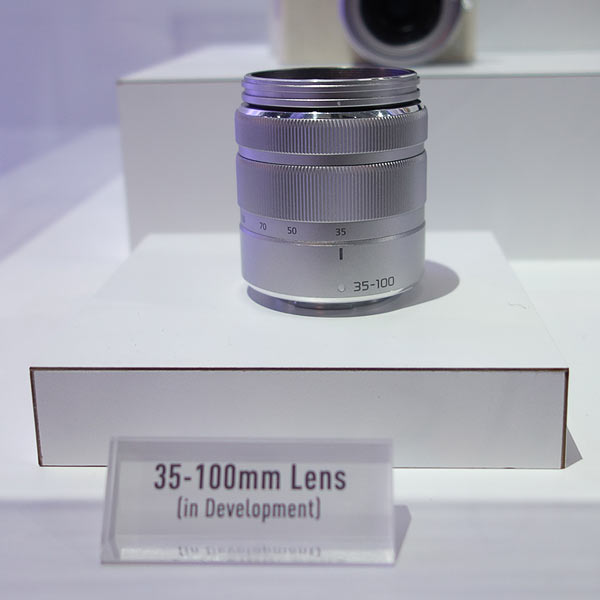 |
At CES 2014 in January, Panasonic showed an amazingly compact 35-100mm (70-200mm equivalent) zoom lens designed to match the size and styling of the Lumix GM1. As of this writing, we still don't have any word of when it will be available or how much it will cost. |
Roadmap for super-compact lenses for the GM1?
DE:�The GM1 has an extremely compact kit lens, can you say anything about other super-compact lenses? At CES, you had mockups of a couple of very compact lenses under glass that I don't think have been released yet.
Uematsu:�The 15mm...
DE:�I think there was a very small zoom also.
Inoue:�...and the 35-100mm. It's almost the same size as our current 14-42mm.
DE:�Can you say anything about when those might come out, or is it still unspecified?
Inoue:�We cannot say.�[laughs]
DE:�So there's no official roadmap with timing for these yet.
Inoue:�No, but maybe coming soon.
[Ed. Note: The 15mm was officially released on March 24. The compact 35-100mm -- distinct from the 35-100mm f/2.8 that's been on the market for a while -- still hasn't been released. From the mockup I saw at CES�though, as shown in the photo above, it's impressively small.]
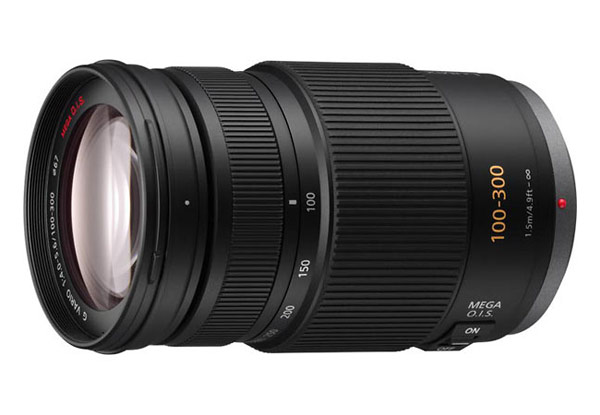 |
Panasonic has had a 100-300mm (200-600mm equivalent) zoom available for Micro Four Thirds cameras for several years now, but some users would like to see both long/fast primes and perhaps tele zooms with larger apertures as well. |
Reader question: What's up with long telephotos and a long tele-zoom lens?
DE:�Also on the topic of lenses, a reader said that he really likes the Micro Four Thirds system very much, but is wondering about the lens roadmap. I don't know what you've published publicly, but are there any plans for a macro lens -- say a 70mm, 80mm, or 100mm? Or what about a really long tele-zoom? I'm not sure what you can talk about, but is there any indication you could give in those areas?
Inoue:�Hmm, very difficult to say... We are still considering the lens roadmap here�[in Japan], and worldwide people's opinion. At this time, we have already pre-released info about the 15mm and 35-100mm, and we have another idea for the lens roadmap, but we can't disclose it at this time, I'm sorry. But we've decided that a long telephoto lens has already been canceled, unfortunately.
DE:�So you had been considering it, but decided there wasn't enough market for it?
Inoue:�Yes, we had been considering, but looking at the overall situation, what it would take for development and what sales there would be, we decided to cancel the long telephoto zoom. We had already released 150mm, but for the zoom, we are very sorry, but this was our decision.
DE:�This is a very related question, it might be what you were just talking about. A reader asked why you removed the 150mm f/2.8 from your roadmap. Are you shifting your focus to shorter focal lengths and GM1 lenses?
Inoue:�Yes. Before announcing the GM1, we had to prepare lenses for the GM design, so we concentrated our lens development on that side. On the other side, though, we have to consider the GH and some somewhat bigger lenses. Also, Olympus has released some good lenses, so we have to compete. That is one new important point!�[laughs]
DE:�That's interesting, so you are having to devote resources to making small lenses for the GM1, but also need to develop more video-capable lenses for the GH4.
Inoue:�Yes, yes. One example of our concentration is that the 42.5mm Leica lens is capable of video shooting. Although it is a Leica lens and the former Leica lenses were not video-capable, this one should be able to be used for video.
DE:�So when you developed the Nocticron, you had the GH4 in mind for it?
Inoue:�Yes, yes, that was a very important part of it.
DE:�The very bright aperture, the very shallow depth of field is very important for videographers...
Inoue:�Yes, exactly. When Uematsu-san visited your office, he mentioned DFD technology is very, very important not only for still shooting, but also for movie recording. With DFD, autofocus can become very, very smooth for video shooting. This is very important for our GH series.�[Ed. Note: DFD stands for "Depth From Defocus", a focusing technology that Panasonic introduced with the GH4. In a nutshell, it uses detailed understanding of the lens' bokeh characteristics to determine how much the subject is out of focus,�and in which direction. Previously, only phase-detect AF systems could provide this sort of quantitative focus information.]
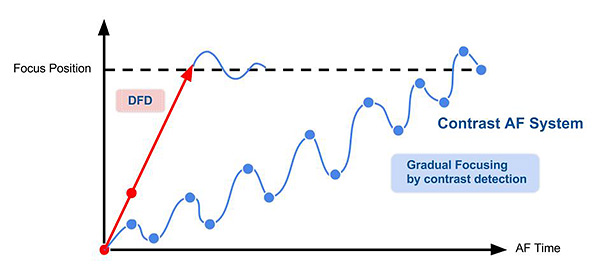 |
Panasonic's unique "Depth from Defocus" (DFD) autofocus system dramatically improves AF speed. The amount and direction in which the lens is out of focus can be determined at the outset, letting the camera adjust the lens very close to the final focal distance without having to stop and check focus along the way, as do conventional contrast-detect AF systems. |
Head over to Imaging Resource to read the rest of Dave's in-depth Panasonic interview. It's so in-depth, in fact, that this is only Part 1! Stay tuned, as Part II will be along shortly.
-----------------------------------------------------------------------------------------------------
QUICK HITS
Sony A77 II Image Quality Analysis: how does the latest SLT handle those higher ISO shots?
by William Brawley
After a quite a long wait, Sony Alpha fans yearning for a new flagship APS-C got their wish with the new�Sony A77 II, which yet again boasts an impressive 24.3MP sensor, though this one's a new iteration and shared with the�Sony A6000. Coupled with Sony's latest BIONZ X image processor, the A77 II claims to have a big boost in high ISO performance -- up to 25,600 rather than the 12,800 as in its predecessor (as well as on the low end, with an extended ISO 50 option).
We've now put the�Sony A77 II head-to-head�against a batch of its major competitors, such as the�Fujifilm X-T1�and�Nikon D7100, as well as the original�A77�using our standard set of�Still L
ife�lab images.�As an example, below is a table comparing the A77 II test lab images to the A77 at base ISO. These are cropped from 100% resolution images to give you an accurate read on what each camera is delivering at default camera settings. As usual, there are also comparisons at ISO 1600 and 3200, as well as a high-contrast, fine-detail comparison table at ISO 6400. And of course our signature�Print Quality Analysis�as well, where we detail how large you can expect to achieve good prints across the entire ISO range.
Head on over to our�Sony A77 II image quality comparison�to see how the various models stack up to each other. Stay tuned for much more to come on the Sony A77 II!
---
Sony RX100 III sample gallery images: Small in the pocket, Big on the trail
by�Dave Pardue
I think you could say Sony's on a roll. The A6000 has been all the rage on our site this year, and there is no shortage of other Sony models vying for attention in their respective categories. But the RX100 line has become�the dominant force in premium compact cameras since the launch of the line in the late summer of 2012.
If the numbers of you who have visited our Sony RX100 III First Shots�news post�or�Samples Page�is a good indication, the RX100 III is on the short shopping list of many a hungry photographic eye these days, ranging from those of you wanting to trade up in the RX100 line, nab a second camera as a smaller option to your primary camera, or by those of you who have yet to take the plunge into the premium compact world and are still shooting with a smaller-sensored point-and-shoot (or are simply frustrated by the limitations of your smartphone).
Whatever your background or experience level, we'll do our best to arm you with as much information as possible in making your own decision, and today's offering is our first set of real-world gallery images.
I was fortunate enough to have a nice Saturday to take my kids to the Appalachian Trail for a morning summer stroll, and we'd just received the RX100 III - a natural fit. I knew that I'd eventually be carrying not only my backpack but also my 4-year-old son as well, so I certainly wanted to travel light. Below are a few shots from the trail, as well as additional examples such as higher ISO shots and special filter modes, re-sized to fit this page and not otherwise altered unless noted. You can access all of the images on our�RX100 III Gallery Page, and by clicking any of the thumbnail images you can access the full resolution image, EXIF data and more.
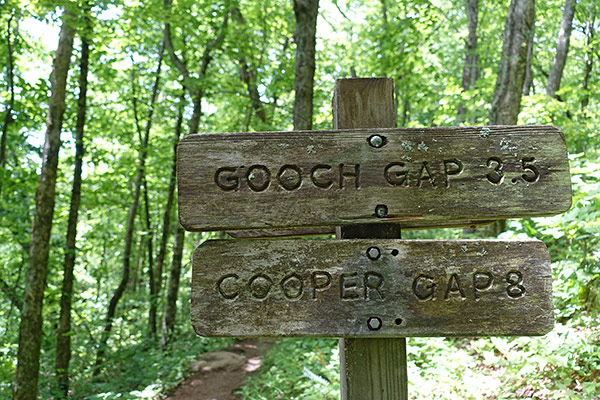 |
31mm eq. / 1/80s / f/2.5 / ISO 125
Getting my bearings on the trail and with the RX100 III - so far so good!
|
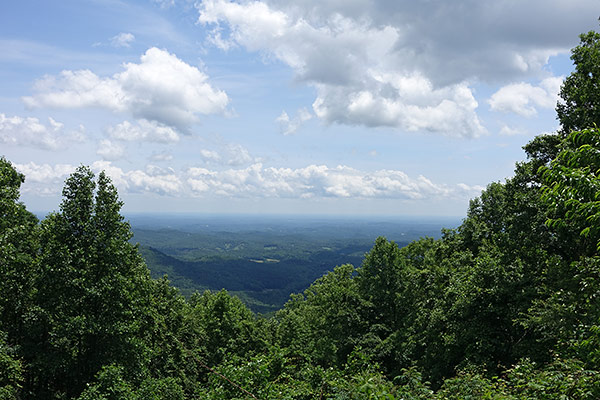 |
40mm eq. / 1/60s / f/7.1 / ISO 125
Viewing the�full resolution version�of this image will show far more detail than a traditional
smaller-sensored compact�could ever hope to achieve.
|
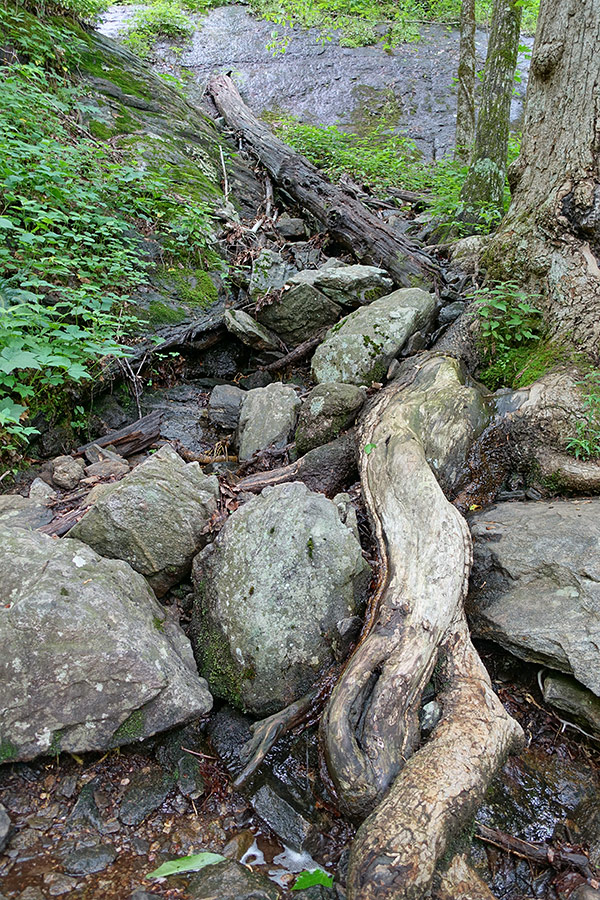 |
26mm eq. / 1/30s / f/2.0 / ISO 200 [HDR lvl 4]
Using HDR level 4 I was able to achieve a more interesting shot than a standard shot
(the non-HDR version is also in the�RX100 III gallery).
|
 |
70mm eq. / 1/80s / f/2.8 / ISO 250 [DRO lvl 5]
With a moving subject I was less likely to achieve good results using HDR, as that requires
multiple images to be fired. Because the background was so blown out here in comparison,
I used the Dynamic Range Optimizer cranked up to level 5 to bring out my subject�(and his obsession with potato chips).
|
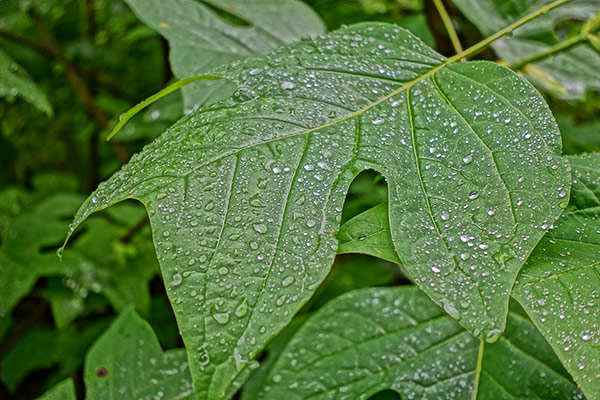 |
70mm eq. / 1/400s / f/2.8 / ISO 400 [HDR Painting (mid level)]
Certain subject matter can yield itself to effects that don't look hokey, and I felt this shot
using the�HDR Painting filter looked intriguing enough to post here.
|
Once back from our mountain excursion I set out to find a few more interesting subjects for the gallery. Once I got used to the RX100 III it certainly was an enjoyable little camera to have along. I miss the additional zoom range of the previous models (100mm eq. for them vs 70mm eq. for this model) but understand that sacrifices are required in outfitting this model with the larger aperture across the available focal range.
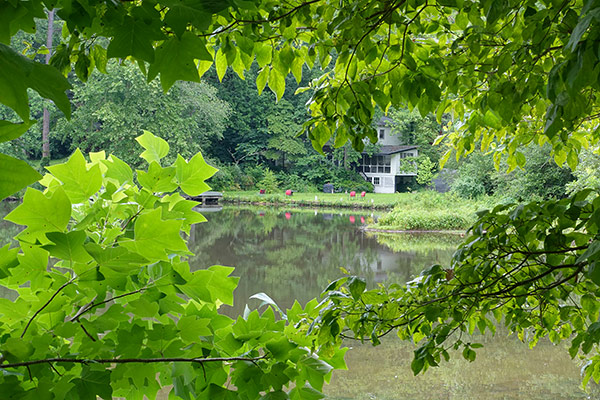 |
70mm eq. / 1/60s / f/8.0 / ISO 400 [HDR lvl 2]
I tried a lower HDR setting on this shot to bring out the leaves in the foreground a bit.
|
 |
70mm eq. / 1/60s / f/2.8 / ISO 160
In general I was very pleased with how the RX100 III renders natural and accurate color,
and the bokeh is pleasing enough given that it's a smaller camera.
|
 |
70mm eq. / 1/6s / f/2.8 / ISO 1250
This was literally shot at true dusk - maybe 9pm. The larger aperture at this zoom range helped
as compared to the previous RX100 versions, and the image stabilization also assisted given that
the shot was handheld (as were all in this series) and at a fairly slow shutter speed.
|
 |
50mm eq. / 1/30s / f/2.8 / ISO 800 [Handheld Night Shot]
Like the HDR mode, Handheld Night Shot fires several images in succession in order to yield a
sharper image at a given ISO and settings than would otherwise be possible. Looking at the�full resolution image�shows the rather remarkable results. Below is a 1:1 crop from the image.
|
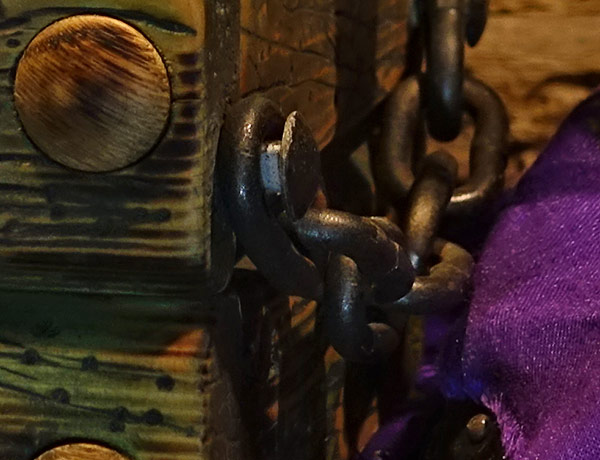 |
1:1 crop from the image above
|
Our Sony RX100 III has shipped out to the competent and experienced hands of Mike Tomkins, one of our senior and most respected reviewers. Stay tuned for much more to come in his RX100 III shooter's reports!
[quick links:�Sony RX100 III���Gallery���First Shots]
-----------------------------------------------------------------------------------------------------
NEW PRODUCT ANNOUNCEMENT
Panasonic FZ1000 beats Sony RX10 with 4K video, more zoom for $400 less! Can it dethrone the king?
by�Mike Tomkins
Finally, the large-sensor, superzoom camera category has a battle on its hands! The 20.1-megapixel�Panasonic FZ1000�is a camera whose competitor is clear: This is a challenger for the Sony RX10's crown, and as you'll see in our�Panasonic FZ1000 hands-on preview, it looks to be a mighty impressive one indeed.
At heart, both cameras are quite similar. The Panasonic FZ1000 and�Sony RX10�are each based around 20-megapixel, 1.0-inch type CMOS image sensors. But the FZ1000 differs from the RX10 (and looks in some ways to be better) in a number of key ways. It's more affordable, yet has a significantly longer 16x zoom range, a noticeably-faster 12 frames-per-second burst capture rate and has 4K video support. It also has a more versatile tilt/swivel LCD monitor, a much higher-resolution electronic viewfinder, a wider shutter speed range, and slightly better battery life.
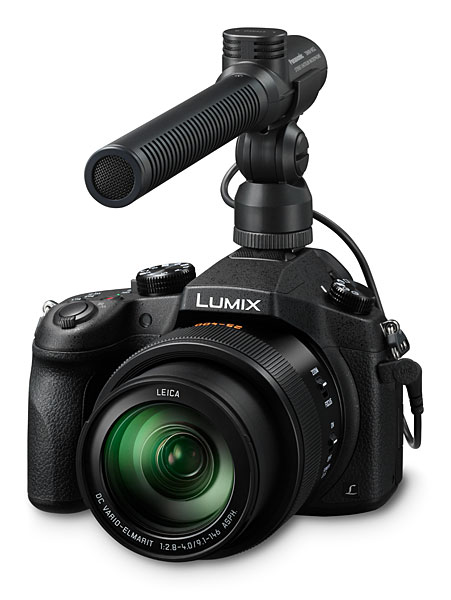 |
The Panasonic FZ1000 looks set to offer a very strong challenge to Sony's RX10, with the same sensor size and resolution, but double the zoom reach and greater performance in an only slightly larger package.
|
On the flip side of the coin, it's rather big compared to its rival, especially in terms of depth. And perhaps not surprisingly, given the much greater zoom reach, it can't boast a constant aperture lens. Instead, its aperture lags that of the RX10 just slightly across most of the range where both lenses overlap. And nor does it provide quite the same wide-angle shooting opportunities.
In most respects, though, the Panasonic FZ1000 looks to give you a similar feature-set to its incredibly popular rival, just with a more affordable price tag and a whole lot more zoom range in a slightly bigger package, plus souped-up video recording with 4K resolution. It's early days yet, but we're already expecting this to be just as hot a camera as the RX10, if not more so.
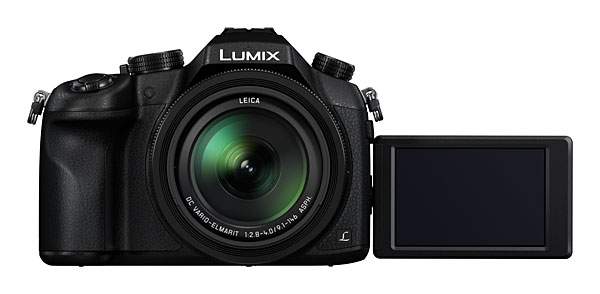 |
Unlike the Sony RX10, the Panasonic FZ1000 has a side-mounted tilt/swivel LCD monitor.
|
Panasonic has set pricing for the FZ1000 at US$900, with availability expected from late July 2014. That makes the new model nearly one-third cheaper than what is, realistically, it's only significant fixed-lens rival, and that's huge news if you're in the market for a large-sensor, long-zoom camera!
Among our just-published�Panasonic FZ1000 samples, you'll find 22 images shot with the camera in our lab, spanning the full range of sensitivities including the extended ISO 80 and ISO 25,600 settings. And we've also added our first�Panasonic FZ1000 image quality comparison, taking a look at how the FZ1000's output compares to that from the Sony RX10 at ISO 125, 1600 and 3200 equivalents.
We've also added our�in-depth technical information section, which answers many of the early questions we've been receiving about the Panasonic FZ1000. It provides a comprehensive look at the camera's features, and how it compares head-to-head with the RX10.
| Panasonic FZ1000 versus Sony RX10 at Base ISO |
 |
 |
Panasonic FZ1000 at ISO 125 |
Sony RX10 at ISO 125 |
The battle of the 1-inch-sensor long-zoom cameras is here, and our image quality comparison shows them side-by-side in carefully-controlled conditions. Above are crops of the same scene at base ISO; you'll find more direct comparisons in our updated�Panasonic FZ1000 review! |
Keen to learn more? We're not surprised, and we're here to help! Read our hands-on�Panasonic FZ1000 preview�for insight into this interesting camera, and direct comparisons against the Sony RX10 based on an in-hand comparison of the two cameras.
Place your pre-order for the Panasonic FZ1000 at one of Imaging Resource's trusted affiliates:
-----------------------------------------------------------------------------------------------------
READER MAIL
Question: Touit vs Sonnar Lenses
I'm saving up for the A7R and I got in a conversation with a Zeiss snob over the Touit lenses. It looks to me like the Sonnar T* lenses are Touit's optimized for the full frame sensors. They even resemble them. Is there any other difference? Should I be considering a Touit lens? Do the Touit lenses expand the lens choice lineup for the A7R or should they be avoided?
I couldn't find any direct comparisons or easy to understand explanations online.
Thanks,
DanJ
Answer:
Hi Dan! Both the Zeiss-Sony co-branded E-mount lenses (three Sonnar and three Vario-Tessar) and the Zeiss Touit series share some features like Zeiss's T* lens coatings, as well as some similar design aesthetics. However, the Touit lenses are strictly for APS-C cameras, as you indicated. There are a couple Sony -Zeiss Sonnar T* lenses for APS-C E-mount cameras as well (24/1.8, 16-70/4), so they aren't just Touit lenses made for full-frame cameras. While the Touit lenses could be mounted to the A7R, the camera would need to be set to its "crop mode" in order to avoid some severe vignetting. The A7R would only use about 2/3rds of the sensor (~15MP) and the A7 would drop to around 10MP, so you'd be losing a lot of sensor real estate in this configuration. If I was an owner of the A7/R camera(s), I would not use Touit lenses.
-William B.
---
Question: Auto ISO on Nikon
Thanks for a tremendous site! Quick question: How useful is the Auto ISO function on our new DSLRs, and how widely is it used by the "guys in the know"?
I have a Nikon D7000 and only started looking at this function now.
Many thanks,
Steve.
Answer:
Hi Steve! Glad you enjoy the site! To answer your question, Auto ISO can be very useful in a variety of shooting situations. I don't know about all the "guys in the know," but it's certain a handy feature when photographing subjects in varied lighting conditions and want or need a certain shutter speed and aperture -- think of it like "almost-full-Manual mode." For example, I've used it when photographing cycling where riders would pass by in shade and in bright sun very quickly. As the riders approached, they might be in shadow for a few seconds, and then ride out into the sun. To get crisp shots, I know I'd want a fast shutter speed, but also a wider aperture at times to help isolate the subject (and assist with that fast shutter speed). In this fast-paced scenario, there's simply not enough time to switch ISOs manually from the shady scene to the sunny one. Auto ISO, then, can help keep a proper exposure.
One thing to watch out for, which your Nikon D7000 supports, are settings for an upper ISO limit as well as a minimum shutter speed limit. This lets you control just how high you'll let the ISO go when using Auto ISO, which lets you keep some control on the the noise by avoiding super-high ISOs while still giving you some exposure control. Similarly, for shutter speed limit, you can set a minimum shutter speed to help avoid things like hand-holding camera shake. The ISO will stay at a level of your choosing, but when the light level drops to a point where the shutter speed needs to go slower than your limit, Auto ISO will kick in to adjust exposure and leave you with a proper shutter speed.
-William B.
---
Question: Suggestion on email
I *REALLY* enjoy your site.
I've participated on links that have you put a specific word in the subject line. For example, you could tell your readers to start the subject line with �question?�. That would let you have a very simple filter that would eliminate a lot of the trash.
Very respectfully,
Larry Root
Answer:
Hi Larry! Thanks for the note. Actually, as long as people use the new nleditor@imaging-resource.com address, we'll be good. That's an address we're keeping away from spambots and aren't giving out to any PR firms, so it should stay relatively "clean" for a good while to come :-)
- Dave E.
---
Question: Hi, I have Aperture editing program and although a gazillion professional edits are available to me I only use about half of them. Do you know where I can get some tips for free?
It seems the world is on photoshop elements but I've come this far and hesitate to switch.
Also any tips on how to "erase" telephone lines easily?
Many thanks,
Susan
Answer:
As usual, Google's your friend here :-) Just search for terms like "free aperture tips", and you'll get a lot of links. In most cases, the site involved makes its living by selling tutorial content, plugins or effects, etc, but you can find a lot of good content posted for free, as teasers or goodwill-builders for their paid content.
This site has quite a few free tips, covering a wide range of topics: http://theapertureblog.com/category/tutorials/ The seem to have either an overloaded server or a very slow connection, as I got several timeouts while trying to browse it, but it looks like there's a lot of material there, if you're patient :-) See the "tag cloud" at the bottoms of their pages, for access to articles on various specific topics. It seems that the site's author makes his money from effects plugins, a book he's published, available on Amazon, and a number of effects presets.
Here's another site that looks pretty interesting: https://www.apertureexpert.com/ They specialize in video training sessions on Aperture. They're free to watch live, and after the fact, you can purchase access to any you're interested in for just $2 per session. There's also an option of $30 for the full set of 25, but it looks like they never got beyond number 9 - it's currently showing it was scheduled for yesterday, 6/13/14, but I also found a post on their site from back in 2011, saying that the same episode was scheduled for then - so maybe buyer beware a little bit on purchasing the full series. They do have quite a few free tips on offer, but they're not organized via a tag cloud as with theapertureblog above, so you'll end up scrolling more.
When it comes to erasing telephone lines from photos, these days I just use the "healing brush" tool in Photoshop. I'm not at all familiar with Aperture, so don't know if there's any equivalent tool there or not. Prior to the healing brush, I just used the "clone stamp tool", which I know Aperture has a version of. Here are links to a couple of tutorials on using it, one in images and text, the second a video: http://www.maclife.com/article/howtos/how_use_clone_tool_aperture, https://www.youtube.com/watch?v=jrnpUk6cW7s
Hope that helps!
- Dave Etchells
-----------------------------------------------------------------------------------------------------
POPULAR ON THE SITE
At http://www.imaging-resource.com/news you can keep track of the photo news on our main site. Among the most popular stories over the last couple of weeks:
-Lens Review: Sony 16-70mm f/4 Zeiss lens review: well-built, lightweight all-around lens for APS-C shooters
http://www.imaging-resource.com/news/2014/06/06/sony-16-70mm-f-4-zeiss-lens-review-a-well-built-lightweight-all-around-lens
- New Sony A7S video footage shows off the camera's incredible performance
http://www.imaging-resource.com/news/2014/06/10/new-sony-a7s-video-footage-shows-off-the-cameras-incredible-performance
- Ever more exciting: Spectacular Sony A7S will boast silent shooting, wider movie sensitivity and more
http://www.imaging-resource.com/news/2014/06/02/ever-more-exciting-spectacular-sony-a7s-will-boast-silent-shooting-wider-mo
- Use a lens adapter, kill the quality?
http://www.imaging-resource.com/news/2014/06/06/non-interchangeable-lenses-how-sensor-differences-can-kill-quality
- Which 50mm lens is the best? Lensrentals' Roger Cicala set out to answer this age-old question
http://www.imaging-resource.com/news/2014/06/05/which-50mm-lens-is-the-best-lensrentals-roger-cicala-set-out-to-answer-this
- Lightroom 6 could see an early arrival this summer; what's on your wish list for the new version?
http://www.imaging-resource.com/news/2014/06/05/lightroom-6-could-see-an-early-arrival-this-summer-whats-on-your-wish-list
- Adobe teases �Focus masks' for Photoshop CC that let you separate objects from defocused backgrounds
http://www.imaging-resource.com/news/2014/06/12/adobe-teases-focus-masks-for-photoshop-cc-that-let-you-separate-objects-fro
- Nikon D300s officially retired by Nikon USA, is there a successor around the corner?
http://www.imaging-resource.com/news/2014/06/09/nikon-d300s-officially-retired-by-nikon-usa-is-there-a-successor-around-the
----------------------------------------------------------------------------------------------------
NEXT ISSUE
-------------------
We'll see you next on June 27, with a regularly scheduled edition (and lots more news and analysis to share)!
SIGNOFF
--------------
That's it for now, but between issues visit our site for the latest news, reviews, or to have your questions answered in our free discussion forum. Here are the links to our most popular pages:
Newsletter Archive: http://www.imaging-resource.com/cgi-bin/dada-nltr/mail.cgi/archive/irnews
Daily News: http://www.imaging-resource.com/news
SLR Gear: http://www.slrgear.com
New on Site: http://www.imaging-resource.com/new-on-ir
Review Index: http://www.imaging-resource.com/camera-reviews
IR Photo Contest: http://www.dailydigitalphoto.com
Google + http://plus.google.com/+imagingresource
Facebook: http://www.facebook.com/imagingresource
Twitter: http://www.twitter.com/IR_Lab
Happy snapping!
Dave Etchells & the IR Editorial Team
nleditor@imaging-resource.com
|

